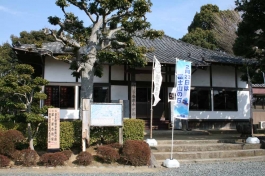Battle of Saigagake Museum
[Route]

| Zip | 432-8014 |
|---|---|
| Address | 25-10 Shikatani-cho, Naka-ku, Hamamatsu-shi |
| Tel | 053-472-8383 |
| Fax | 053-472-8383 |
| Hours | 9:00am-5:00pm |
| Admission | Free |
| Close | Mondays Days after Holidays New Year Holidays |
Establishment
Battle of Saigagake Museum (Saigagake Shiryōkan) is a temple called Sōendō which is dedicated to spirits of soldiers died in Battle of Mikatagahara. It was also used for a long time as base of Association of Enshū Dainebutsu, a traditional festival in Hamamatsu. Enshū Dainebutsu became a designated intangible folk cultural property of Hamamatsu in March 1972. The building was reformed to be a museum to displays documents and materials regarding the festival and the battle in 1982. It was opened in April 1983. It aims to preserves the local cultural heritages for future generations.
Contents
There is a legend on Battle of Mikatagahara that Takeda army fell into a cliff, Saikagake, when they passed the bridge made with cloth by Tokugawa army. The area is now called Nunohashi (Cloth Bridge). The museum is surrounded by monuments related to the battle including monuments of Natsume Yoshinobu, who died being scapegoat of Ieyasu, and Honda Tadazane, who was shingari (the person who stays behind and allows his army to flee). The one of Honda stands as though it is staring at the cliff. Enshū Dainebutsu is one of the traditional folk arts in Enshū area. Performers dance on the request of families in their gardens on their hatsubon, the first year since of death of a family member. It was held in about 280 villages at the time when the festival was the most popular in Edo period. Today, 70 groups belong to Enshū Dainebutsu Preservation Association and perform it.
Remarks
People were afraid that the cliff was cursed because many died in the incident mentioned above. Thus, Ieyasu brought a monk from Mikawa, a region now is the east part of Aichi. He played bells and drums seven days and nights. Since then, Ieyasu encouraged people to perform Nenbutsu dance, and Dainenbutsu became popular in Enshū area.